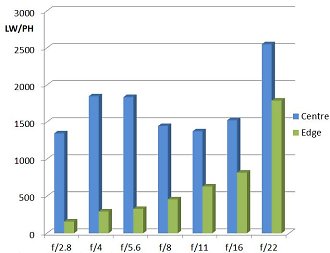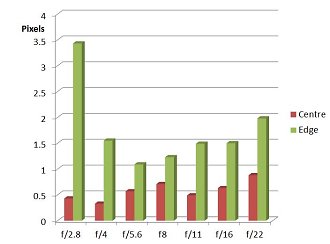Lomography LC-A Minitar-1 32mm f/2.8 Art Review
Lomography LC-A Minitar-1 32mm f/2.8 Art Performance
It could be argued that that the low standard of technical performance found is, in fact, the lens living up to its design. The results of the lens test would normally not be encouraging, with very poor edge performance at open aperture, improving on stopping down but never really approaching even fair levels. Only at f/22 does the Minitar approach a good level of edge sharpness.
The centre of the field does look somewhat sharper, with fair central performance wide open, rising to good levels at around f/5.6 and again peaking at f/22 where we find very good sharpness. This is counter-intuitive and I would normally feel that this showed a heavily de-centred lens, but here we have a deliberate design.
How to read our charts
The blue column represents readings from the centre of the picture frame at the various apertures and the green is from the edges.The scale on the left side is an indication of actual image resolution as LW/PH. The taller the column, the better the lens performance. Simple.
For this review, the lens was tested on a Sony Alpha A7 using Imatest.
This is further evidenced by the level of CA being quite well-controlled throughout, with the exception of the edges at open aperture. CA is not really a problem. Distortion is quite high at +3.48% pincushion.
How to read our charts
Chromatic aberration is the lens' inability to focus on the sensor or film all colours of visible light at the same point. Severe chromatic aberration gives a noticeable fringing or a halo effect around sharp edges within the picture. It can be cured in software.Apochromatic lenses have special lens elements (aspheric, extra-low dispersion etc) to minimize the problem, hence they usually cost more.
For this review, the lens was tested on a Sony Alpha A7 using Imatest.
The Minitar is prone to flare when shooting against the light, but otherwise provides characteristically unsharp but highly saturated images. This is the style of Lomography, and with the lens are provided two booklets with many highly effective examples of the art form. One of my thoughts regarding lenses in general is that so often manufacturers are not specific enough about the design choices put into their lenses. In the case of the Lomo Minitar Art Lens this is most definitely covered superbly and a search of the internet will yield many examples of Lomgraphy and a wealth of groups to join.
In this sense, the lens is less about its technical performance and much more about its particular optical characteristics that encourage freedom of expression and a release from the technical perfection we so often seek. There are similar approaches available in the form of pinhole cameras and pinhole lenses for CSC systems, as well as the wide range of Lens Baby lenses and the other lenses in the very interesting Lomo portfolio.
Value For Money
The method of manufacture of the Lomo Art lenses is of a high and more traditional level, so this does not come cheap. At £249 I feel this is reasonable value for money, and certainly if you want the sort of visual style that the lens offers then we have something unique at an affordable level.
Alternatives might include the LensBaby range, the Composer Pro + Sweet 35 being the closest to the Lomo at £244. Other alternatives include the body cap lenses. Olympus offer the M. Zuiko 15mm f/8 Body Cap lens at £59. They also have the 9mm f/8 Fisheye Body Cap lens at £75. Users of the Pentax Q system have the 07 Mount Shield 11.5mm f/9 lens at £49. All of these have their own particular and unique characteristics.
Add your message
Please login here or if you've not registered, you can register here. Registering is safe, quick and free.
photodo Stats
428 MTF tests
74 in-depth photodo reviews
100+ users join each day
Help the lens community by reviewing or rating a lens today via our lens search
Latest Lens Reviews
- Chinon 28mm f/2.8 Vintage Lens Review
- Canon EF 70-200mm f/4L IS II USM Lens Review
- Samyang AF 85mm f/1.4 EF Review
- Sigma 70mm f/2.8 DG Macro Art Review
- Samyang AF 24mm f/2.8 FE Review
- Meike 50mm f/1.7 Review
- Tamron 70-210mm f/4 Di VC USD Review
- Lensbaby Burnside 35mm f/2.8 Review
- Asahi Super Takumar 50mm f/1.4 Review
- Asahi Super-Multi-Coated Takumar 135mm f/3.5 Review


